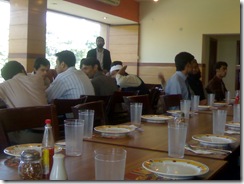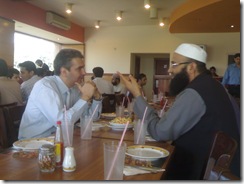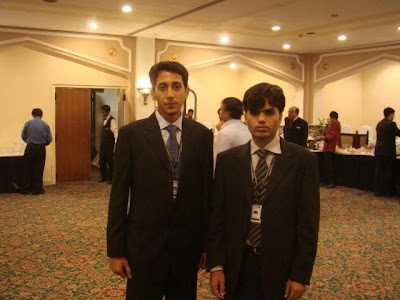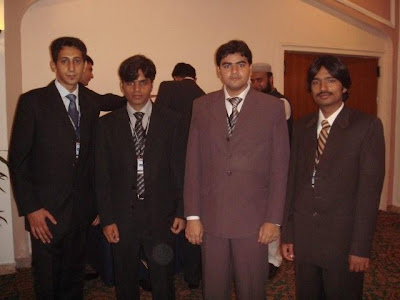ERP has been a two-horse race between SAP and Oracle for years. Microsoft's Chris Caren is battling to change that, with the company's Dynamics ERP and CRM products. Here's his take on what Dynamics is delivering to enterprises as compared with its entrenched rivals.
By Thomas Wailgum
October 29, 2008 — CIO — Enterprise software analysts and industry observers usually refer to the competition in the ERP and CRM space as essentially a two-horse race between Oracle and SAP. The breadth of applications in both vendors' stables, their collective R&D budgets, and the fact that these giants aren't shy about buying up the competition cements that market reality.
But watch out, SAP and Oracle. While continuing to bludgeon and attack each other as they go after SMBs, both vendors now must look over their shoulders at hard-charging Microsoft and its burgeoning Dynamics set of business applications.
"Microsoft remains a relative newcomer to the business applications market," notes Warren Wilson, a research director at Ovum, in a report. "However, it is committing more and more resources to its Dynamics solutions, and its ability to integrate Dynamics with its ubiquitous Windows applications—especially Office—makes Microsoft a threat that neither SAP nor Oracle can afford to take lightly."
CIO.com Senior Editor Thomas Wailgum recently talked with Chris Caren, general manager of product management and marketing for Microsoft's Dynamics line of ERP and CRM products. Caren described the overriding strategy for the Dynamics line and how the software will take advantage of users' familiarity with the Office suite. He also explained why he thinks on-premise and cloud computing options won't hurt Microsoft's business, and offered his take on how Microsoft is competing—and winning—against Oracle and SAP in midmarket and large organizations.
CIO.com: What's been Microsoft's strategy with Dynamics so far?
Chris Caren: Whether it's us talking to our customers or analysts like AMR, or doing studies of the market, we view business applications—and I'd say this both applies to ERP and CRM—as long-existing categories of software that are woefully underutilized and underused inside of organizations.
I think AMR did a poll and found on average about 10 percent of employees are licensed to use a business application, and of those 10 percent, only about half actually access the application as part of their job. So, the footprint inside of organizations is incredibly limited.
Whether it's business applications or other categories of software like business intelligence, we really believe there's a huge opportunity to democratize the application and get it much more broadly used in organizations for both increasing the productivity of employees and letting them be more effective in their jobs. But also to give them, in the case of business applications, better information for decision-making—just to help them work a lot more intelligently and a lot smarter.
CIO.com: Does that tie into Microsoft's existing product sets?
Caren: The core approach to our product strategy is to overcome the inflexibility and the ease-of-use issues that have limited adoption of business applications, and for us that means really blurring the lines between what a business application is and what the world of Microsoft Office is.
And by that I mean not just Microsoft Office, the desktop suite of products, like Outlook and Excel and Word, but more and more the business server applications like SharePoint for collaboration, PerformancePoint for business intelligence, or Office Communications Server for instant messaging, presence, and voice over IP.
CIO.com: So making sure that the user interface and basic tools were easy to use has been a huge part of Dynamics' roadmap?
Caren: Yeah, one big part of it is just that: making the user experience really approachable, familiar. Part of our strategy is preconfiguring it to the types of things you'd likely want to do if you're a salesperson or a payroll manager or a marketing manager. So, we focus on kind of consumerizing the user experience so it looks a lot more like a consumer Web application, a lot less like business software. And we're building what we call these role-tailored user experiences, which is prepackaging what we think a vast majority of employees are going to want to do with the business applications.
CIO.com: Clearly you have a huge advantage in the SMB space, because people's familiarity with Office and Excel. But you also have to show some power behind those applications?
Caren: Yes, definitely. If you look, for example, at our CRM application, the majority of the revenue for that business comes out of the enterprise space. So, to your point, while our product strategy really resonates with mid-market customers, we're having a lot of success at the large enterprise and in the public sector where we have very large projects as well.
CIO.com: When I talk to CIOs, IT staff and users who have these big installed systems, privately many will tell me how much people revert back to Outlook or Excel and reject these new big systems that come in and seem too complex. You've probably heard that a lot?
Caren: I think that's very true. Actually, the experience that drew me to join the Microsoft Business Solutions group was an interesting one. It was out in the Midwest with one of the largest oil companies in the world, and they're a big SAP customer and a big Microsoft customer, and I was meeting with their senior IT leaders.
After a long discussion, just about how they think about Microsoft and how they think about SAP, one of the gentleman basically came to the realization and said: You know, we actually don't run our business with SAP; SAP is the place at the end of the week that we put in some high-level numbers to keep finance happy, but we run our business day-in and day-out, we make decisions, we do analysis, we collaborate with e-mail and with Excel.
Our goal is to let companies continue to collaborate and make decisions, share information using Excel and e-mail, but have it be attached to the kind of workflows and processes that companies want to have their employees follow, and have the data be in Excel, but have it be secure and current so that everyone has the same view of the business.
It's letting you stay where you naturally want to work and keep that flexibility, but get the benefits of having really efficient structured workflows and very secure and auditable information, and to be able to access and make decisions on.
CIO.com: Would you say that one of the challenges over the years has been to get the word out to these businesses that when they think of ERP and CRM, they should consider Microsoft?
Caren: Yeah, I'd say one of the biggest areas of focus for me is building category awareness, so that when a senior executive, whether IT or business, thinks about the business application purchase, they know Microsoft has really compelling solutions. It still is an area of work for us.
CIO.com: How do you sell them on Microsoft's business applications?
Caren: We talk a lot about the traditional experience of using a business application. So, you spend a lot of money upfront to buy the software, spend a lot of money to train your employees, and you spend even more over time maintaining the system and trying to evolve it to keep up with how you do business. And despite all those investments, the traditionally very narrow user population and the end value the company gets back in return on investment, it's a lot more limited than it could be.
Then we just talk about a world where business applications are self-service, are flexible, and are used by a majority of employees, and how much better that world is for IT, and how much better that world is for their employees and their management.
We talk a lot about Office as the user experience and we talk a lot about how well our business applications leverage the Microsoft server infrastructure to really minimize the cost of owning the application year-in and year-out, which traditionally is another big negative companies and CIOs have about CRM and ERP—just the incredible cost of maintaining the applications.
CIO.com: An article I just wrote in September was about a very small business that ended up purchasing SAP ERP applications, when in the past, they probably would have gone with Microsoft. I thought it was an interesting case because this company, who had like 10 users on the SAP system, was not what we generally think of as SAP ERP customer. So as SAP and Oracle start invading this space, where before there wasn't a ton of people going after the 12-seat companies and Microsoft applications were king, how do you see the competition playing out?
Caren: That kind of leads to the second point that's core to our strategy. You mentioned overcoming the ease of use and inflexibility that limits adoption. The other one that is core to our strategy is working through partners to serve customers—meaning building a great, flexible application, but then relying on a really strong, healthy channel to build vertical and micro-vertical solutions that particularly for the mid-market help a customer not just buy an ERP system but buy an ERP system that, for example, works for frozen fish manufacturers.
It's a solution that's much closer to what you need, in the end, that's off the shelf—although off the shelf from a partner, so you get the solution faster and you spend a lot less money on it. It's also the local partner that can really augment or in some cases handle the needs of a company that doesn't even have an IT department. That local touch that our channel provides really gives a strong advantage in the mid-market.
So, to your point, despite Oracle and especially SAP talking about their mid-market focus, we really haven't seen a huge impact on our ability to win business there, and I think that's in large part due to our strong partner channel.
CIO.com: So, when you're going into the RFPs, who is your competition?
Caren: It's typically SAP or Oracle, and then it probably is a combination of two or three mid-market specialists, these firms like a Sage or an Epicor, and in the case of many international deals a local French competitor, a German competitor. In the enterprise ERP and CRM market, obviously there are a few players that have high share. In the case of the mid-market it's an extremely long tail and a very small head in terms of the share of markets from different ISVs.
CIO.com: You had previously worked on Duet, Microsoft's product partnership with SAP. What's the status of that partnership? It seems to me that, in the future, if you're going in and selling against SAP's product, to have kind of this complementary product, maybe that's not great for either of you.
Caren: I'd say Duet was one of the hottest products I think SAP ever saw when it showed it to its installed base, because of the great ease-of-use story it brought to their customers. Duet today serves a narrow set of scenarios. Of the hundreds of different workflows that SAP enables, probably a dozen, at most, are handled today by Duet. So, for some customers it's a great fit; for many it's a great vision, but not yet delivering on what they as an organization most need.
Duet is all about SAP's large enterprise business suite, and there we really don't focus our ERP business. Our ERP business is much more mid-market up through the enterprise segment and more like subsidiaries or divisions of global 2,000 companies. So, where SAP is [selling] at the headquarters of Global 2000, we're at the subsidiaries of those organization or in the mid-market.
CIO.com: As Microsoft expands its Live on-demand and cloud computing product lines, do you see those as just different product offerings for different types of businesses, on a different service? Or products at fundamental odds with each other?
Caren: For CRM, where we have obviously an on-premise business and we have CRM Online, which has been in market for nine months, we see the sort of same representation of customers using either offering—meaning CRM Online is not about small business where CRM on-premise is about enterprise and mid-market. We see the same representation across enterprise, mid-market and small business for our CRM on-premise business and for our CRM Online business.
The deployment decision tends to be secondary to the vendor decision from what we're seeing, versus customers saying I want to go on-premise or in the cloud, and then have a list that's just more mapped to those companies with those kinds of solutions.
CIO.com: So, in your mind and in Microsoft's mind, those two business models can coexist? Some of these pure SaaS vendors contend that these are like apples and oranges—they're so different that for Microsoft to offer both just seems not right or doesn't seem like it's good business.
Caren: We see a certain segment of customers that say: I want to be in the cloud, maybe because I don't have an IT department or I can't wait for IT to serve my needs. So cloud-based is the only way for me to go.
Other [customers] tend to have more of a traditional view of liking the on-premise deployment method for a number of reasons, whether it's ownership of the data inside their four walls or owning the application start to finish.
We see more and more customers that like that flexibility to be able to start with a hosted service and either over time stay there but always have the flexibility to pull it in-house if they end up wanting to do a lot of deep integration between the CRM application and the other legacy applications they have. That flexibility is more and more becoming a big selling point for our customers.
CIO.com: We know that Vista and operating systems and Office garner a lot of the attention from the press and certainly from everyone who thinks of Microsoft, but just how much going forward is Microsoft looking to Dynamics to contribute?
Caren: The aspiration is definitely to become a multibillion-dollar organization, and right now we're over a billion but not yet at multibillion, which means high growth rates. Right now I think our latest reported growth was 21 percent year over year, which is about triple the growth of the market overall.
For people like Steve Ballmer, it's an incredibly strategic business, because it really is the linchpin of the overall solution Microsoft hopes to deliver to customers. It's the application leveraged by our platform, if you look at our Windows and BizTalk and SQL platform business, and it becomes more and more a showcase application to be delivered to end users through the Microsoft Office business, which is just another very important core to our business strategy.
So the platform beneath it, the world of Office on top of it, makes it a really important part of the solution we're trying to encourage our customers to adopt.








































































































